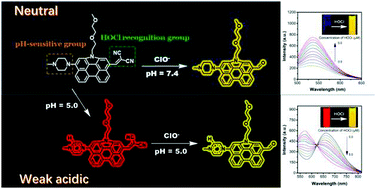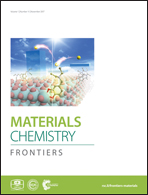A pH-sensitive multifunctional fluorescent probe based on N-annulated perylene for the sensitive and selective detection of hypochlorous acid†
Abstract
Hypochlorous acid (HOCl) is a representative reactive oxygen species (ROS), which play important roles in signaling and homeostasis. And it is also an important cobleaching agent and disinfectant in industry and life. Therefore, it is of significant importance to detect HOCl accurately for the diagnosis or treatment of various diseases and the protection of the environment. Considering its excellent photophysical properties, N-annulated perylene (NP) was chosen as the fluorophore to design a multifunctional fluorescent probe for the sensitive and selective detection of HOCl for the first time. Benefiting from the introduction of a piperazine moiety, the probe became pH-sensitive due to the photo-induced electron transfer (PET) process. In a neutral environment, PNPM was a turn-on probe towards HOCl with a limit of detection of 31.7 nM. However, PNPM became a ratiometric fluorescent probe under weakly acidic conditions with a better limit of detection (15.3 nM). This amazing property meant that the probe possessed the ability to detect pH and HOCl at the same time. Therefore, PNPM was successfully employed to detect HOCl in fetal bovine serum and different water samples, where it could also monitor the pH values of the solution, showing its huge potential in practical applications.

- This article is part of the themed collection: Molecular Materials and Devices


 Please wait while we load your content...
Please wait while we load your content...